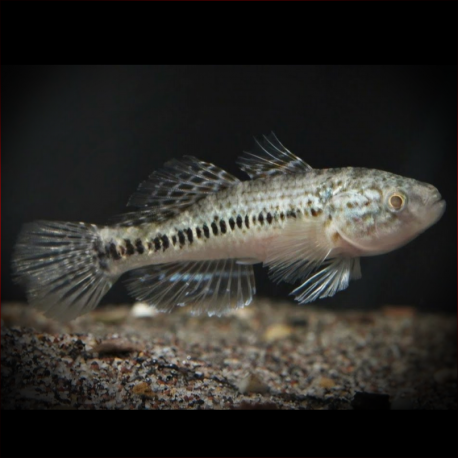More info
Datasheet
| Minimum Tank Size | 70 litres / 18.49 US gallons |
| Maximum Size | 12.0cm / 4.72inches |
| Temperature | 22°C / 71.60°F - 26°C / 78.80°F |
| Hardness | 10-20ºdH |
| pH | 7.0-8.5 |
General Description
The Clay Goby, scientifically known as Dormitator Lebretonis, is a peaceful fish that adds to the brackish or hardwater communities of medium-sized fish. It was previously classified under the now-defunct Batanga genus and is native to Western Africa. The species showcases vibrant red and blue patterns as adults, although they are rarely available in the trade.
Aquarium Setup
For optimal care, a minimum tank size of 70 litres is recommended, equipped with a soft sandy substrate and ample caves and hiding spots where the Clay Goby can establish territories. The species thrives in brackish water conditions, with a salinity of around 1.005sg, but can also adapt well to hard, alkaline freshwater environments (see table). Dim lighting in the tank encourages daytime activity and visibility.
Behaviour
Considered peaceful overall, the Clay Goby can exhibit territorial behavior, especially amongst rival males. It is compatible with other hardwater or brackish species that occupy different tank levels, such as archer fish, chromides, rainbowfish, Monos, and Chanda species. However, due to its opportunistic nature, it may prey on smaller tank mates and nip at the fins of slow-moving or long-finned species.
Feeding and Diet
The Clay Goby is an undemanding eater, accepting a varied diet of dried, frozen, and live foods. It also appreciates vegetable matter in its meals and may graze on green algae if available in the tank. Supplementing its diet with blanched spinach or nori (dried seaweed) can provide additional nutritional value.
Reproduction & Dimorphism
While breeding the Clay Goby has been achieved in captivity, documentation on the process is limited. Reports suggest that spawning occurs in caves or on plant leaves if caves are absent. There is uncertainty regarding whether the species requires freshwater or brackish water for successful breeding. Male Clay Gobies develop elongated rays in the anal and second dorsal fins, along with a potential nuchal hump as they mature.
Habitat and Distribution
Native to Western Africa, the Clay Goby inhabits coastal waters, including estuaries, lagoons, and mangroves. Its distribution spans regions such as Senegal, Gambia, Guinea, Cote d'Ivoire, Ghana, Benin, Nigeria, Namibia, and Angola. The species predominantly occurs in brackish waters but has also been documented in freshwater habitats.

